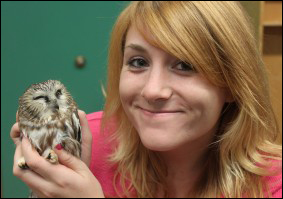Northern Saw-whet Owl Banding Program
14 September - 27 October 2012
Owl Count = 35
 Mark Manske of Adirondack Raptors with a Northern Saw-whet Owl at the Paul Smiths VIC Banding Station
Mark Manske of Adirondack Raptors with a Northern Saw-whet Owl at the Paul Smiths VIC Banding Station
The Northern Saw-whet Owl Banding Program began on 14 September and ran through 27 October 2012. The intent was to continue the program until 4 November, but the nets were pulled early due to the impending inclement weather. 35 owls were banded. The project is one of the research programs run by Adirondack Raptors, a privately owned business that monitors and studies the local raptor populations. The Northern Saw-whet Owl (NSWO) is a small owl that lives in woodlands and preys mainly on mice. The goals of the Paul Smiths Saw-whet Owl Research Program (which was established in 2011) are to:
- Monitor long-term changes in Northern Saw-whet Owl populations
- Track timing of migration of age/sex groups
- Study stopover patterns
- Study molt and other aspects of biology in NSWOs
- Use owls and owl banding to educate the public about conservation and wildlife issues
- Train volunteers in bird-banding techniques
- Train students in raptor research methods
 This
year, the owl
banding station was open to the public on a first come first
serve basis, starting 1 October and running through to the end of
the season. The activity started at sunset each night. Those wishing
to participate registered in advance. (Walk-ins were not accepted.)
The cost for a night was $10.00 per student on owl nights (Saturdays
from 5:00 through 11:00 PM in October) and $20.00 for adults. On
these days, Adirondack Raptors
brought in owls and did presentations about each owl before the
station was opened.
This
year, the owl
banding station was open to the public on a first come first
serve basis, starting 1 October and running through to the end of
the season. The activity started at sunset each night. Those wishing
to participate registered in advance. (Walk-ins were not accepted.)
The cost for a night was $10.00 per student on owl nights (Saturdays
from 5:00 through 11:00 PM in October) and $20.00 for adults. On
these days, Adirondack Raptors
brought in owls and did presentations about each owl before the
station was opened.
For people wishing to be part of the banding team and get a more personal experience, the cost was $50.00. The activity started on those nights at sunset and ran till 11:00 PM or later (depending on bird activity). As with all animals, there were nights when no birds were caught, but October is when the majority of saw-whets are migrating through, providing the best chance to see an owl.
The Paul Smiths College Visitor Interpretive Center's Saw-whet Owl Banding Station is a member of Project Owlnet, a series of banding stations throughout Canada, the United States, and Mexico that is tracking the smallest owl in the northeastern part of North America.
